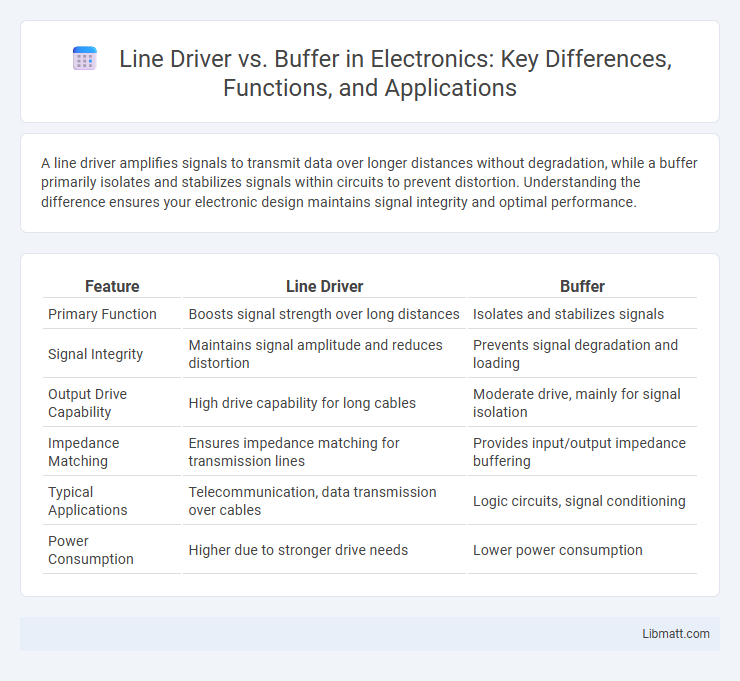A line driver amplifies signals to transmit data over longer distances without degradation, while a buffer primarily isolates and stabilizes signals within circuits to prevent distortion. Understanding the difference ensures your electronic design maintains signal integrity and optimal performance.
Table of Comparison
| Feature | Line Driver | Buffer |
|---|---|---|
| Primary Function | Boosts signal strength over long distances | Isolates and stabilizes signals |
| Signal Integrity | Maintains signal amplitude and reduces distortion | Prevents signal degradation and loading |
| Output Drive Capability | High drive capability for long cables | Moderate drive, mainly for signal isolation |
| Impedance Matching | Ensures impedance matching for transmission lines | Provides input/output impedance buffering |
| Typical Applications | Telecommunication, data transmission over cables | Logic circuits, signal conditioning |
| Power Consumption | Higher due to stronger drive needs | Lower power consumption |
Introduction to Line Drivers and Buffers
Line drivers and buffers serve critical roles in signal integrity and data transmission within electronic circuits. A line driver amplifies and conditions signals to ensure they can travel long distances with minimal distortion, whereas a buffer isolates and stabilizes voltage levels between circuit stages to prevent loading effects. Understanding their distinct functions is essential for designing reliable communication interfaces and optimizing performance in complex digital and analog systems.
Defining Line Driver: Purpose and Operation
A line driver is an electronic device designed to amplify signals for transmission over long distances, ensuring signal integrity and strength. It operates by boosting the voltage or current of the input signal to overcome potential losses in cables or circuit paths. Its primary purpose is to maintain signal quality and reliability in environments with significant electrical noise or extended wiring.
Understanding Buffers: Key Functions Explained
Buffers serve as essential electronic components designed to isolate different circuit stages, ensuring signal integrity and preventing signal degradation. They regulate voltage levels and provide current amplification without altering the original signal waveform. Unlike line drivers, buffers primarily focus on impedance matching and noise reduction rather than driving signals over long distances.
Core Differences Between Line Drivers and Buffers
Line drivers and buffers differ primarily in their signal amplification and impedance matching capabilities. Line drivers are designed to boost signal strength for long-distance transmission, ensuring minimal signal degradation over extended cables. Buffers mainly stabilize and isolate signals to prevent loading effects, making your circuits more reliable without significantly increasing voltage levels.
Typical Applications of Line Drivers
Line drivers are commonly used in telecommunications, audio equipment, and digital data transmission to amplify signals for long-distance communication. Their robust design ensures signal integrity over extended cable runs, making them ideal for applications such as RS-232, RS-485, and Ethernet interfaces. Your system benefits from line drivers when needing reliable and noise-resistant data transfer across multiple devices or complex networks.
Common Use Cases for Buffers
Buffers are commonly used in electronic circuits to isolate different stages, prevent signal degradation, and improve overall system stability. You'll often find buffers in audio equipment, communication systems, and data acquisition devices, where maintaining signal integrity is crucial. By providing impedance matching and driving capability, buffers ensure consistent performance across various applications.
Signal Integrity: Line Driver vs Buffer Performance
Line drivers are designed to boost signal strength, ensuring robust transmission over long distances by minimizing signal attenuation and maintaining voltage levels. Buffers primarily provide signal isolation and drive capability, preventing signal degradation caused by loading effects and improving overall signal stability. In terms of signal integrity, line drivers excel at preserving signal amplitude and reducing noise, while buffers focus on maintaining signal shape and timing consistency under varying load conditions.
Power Consumption Comparison
Line drivers typically consume more power than buffers due to their ability to drive higher current loads over longer distances, which requires greater energy output. Buffers, designed to isolate and stabilize signals with minimal power usage, offer a more efficient solution when driving short distances or lighter loads. Understanding your system's power budget helps you choose the right component for balancing performance and energy efficiency.
Integration in Modern Circuit Design
Line drivers and buffers play crucial roles in modern circuit design by ensuring signal integrity and proper voltage levels across various components. Integration of line drivers within integrated circuits enhances the ability to drive long transmission lines with minimal signal degradation, while buffers protect sensitive inputs from loading effects and stabilize signal transitions. Both elements optimize data transfer efficiency and reliability in complex systems such as communication interfaces, microprocessors, and high-speed digital circuits.
Choosing Between a Line Driver and a Buffer
Choosing between a line driver and a buffer depends on the specific signal integrity and driving requirements in electronic circuits. Line drivers excel at driving high-capacitance loads over long cables with strong output current, while buffers are ideal for isolating signal stages and providing voltage level restoration with minimal delay. Evaluating factors such as load impedance, transmission distance, and signal speed is crucial for selecting the optimal component for reliable data transmission.
Line Driver vs Buffer Infographic

 libmatt.com
libmatt.com